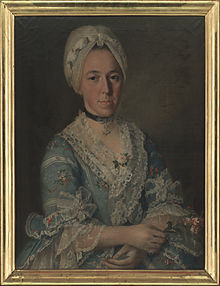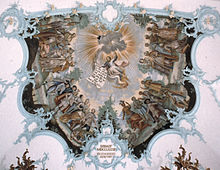Ursula Wolf-Zellweger
Ursula Wolf-Zellweger (* July 20, 1735 in Lyon ; † May 11, 1820 in Trogen AR ) was the daughter of Johannes Zellweger-Sulser and the donor of the paintings in the Reformed Church of Trogen .
Life
Ursula Wolf-Zellweger was born in Lyon as the daughter of Johannes Zellweger-Sulser and Ursula Zellweger-Sulser . She was born into the textile trade family Zellweger , which belonged to the rural upper middle class, who had gained wealth and reputation at the time of proto-industrialization in Appenzell Ausserrhoden through the long-distance trade in cotton. Ursula Wolf-Zellweger had six siblings, all of whom were also born in Lyon, including the future businessman and governor Jakob Zellweger-Wetter , the businessman Johannes Zellweger-Hirzel and Anna Honnerlag-Zellweger , who was married to the businessman Johann Conrad Honnerlag . Two of her siblings died at a young age.
After the early death of her mother in 1737, Ursula moved to Trogen with her father and siblings in 1740 as a five-year-old girl. There she married on July 12, 1775 Johann Conrad Wolf, who was employed by her brothers Jakob and Johannes as private tutor. After the marriage, Johann Conrad Wolf lived as a privateer and devoted himself to his theological studies. The marriage remained childless.
Ursula Wolf-Zellweger is often praised for her charity. She donated significant sums to the building of the reformed church in Trogen and donated the ceiling paintings. According to the family chronicle, she bequeathed around 10,000 guilders on her death, her husband around 300 guilders. Compared to their brothers Jakob Zellweger-Wetter and Johannes Zellweger-Hirzel, who left behind a fortune of 2 million and 3 million guilders respectively on their death, the fortunes of the Wolf couple seem rather modest.
Construction activity
In 1786, Ursula and Conrad Wolf-Zellweger had a four-storey, knitted hipped roof house built over a square ground floor in Schopfacker, located on the country road to Heiden , which after Ursula's death in 1820 became the property of the Trogner Sturzenegger family and has remained to this day. From 1917 to 2007 a veterinary practice was housed in it.
When the Reformed Church in Trogen was built from 1779 to 1782, Ursula Wolf paid for the painting on the ceiling either alone or together with her husband Johann Conrad Wolf. These pictures in the Rococo church are unique for a Zwinglian house of worship , as at that time there was usually a ban on pictures in Reformed churches and the churches were built as simply as possible. Here graces above the west gallery a picture of but Supper the ceiling and above the nave are Ascension of Christ and Jesus depicted as a lover of children.
Above the choir there is a picture that shows Christ in the center, calling the four continents of Asia , Europe , America and Africa to follow. The continents are represented by seven to nine figures each, which are assigned to the continents based on clothing, skin color and other attributes. In the group of eight European people there are notably two women in traditional Appenzell costumes : One of these women may be a maid or maid of the second woman standing to her right. The latter draws the attention of the viewer, since it is the only one looking directly at the viewer. Due to her clothes and a note in the family chronicle, she can be identified as Ursula Wolf-Zellweger. The founder had herself immortalized in a painting she paid for. To the right of her stands a man who may represent her husband Conrad Wolf. He grabs his heart with his right hand, with his left hand he points to the construction date and his gaze is directed to Ursula. Unfortunately, the identification of the man cannot be clearly proven. It is unknown who painted the paintings. If it was previously assumed that a Catholic church painter would be the author, this thesis is now more likely to be negated. It is possible that the painter is an unknown, local artist, but this assumption cannot be conclusively confirmed either.
The representation of the four continents for representational purposes was popular in the secular environment of the 18th century, especially among urbane merchants. The portraits of the four continents in the private houses had the function of placing the master of the house in the center of the world. That this motif now appears in a church is unique. It places the Lord of the House of God - God - in the center of the world.
literature
- Victor Eugène Zellweger: Chronicle of the family Zellweger von Trogen. Trogen 1891 - approx. 1930. (In the canton library of Appenzell Ausserrhoden )
- Matthias Weishaupt: ties of respect and love. Eleven portraits of the Zellweger family from the 18th century , Traber, Wald 2000.
- Bernhard Anderes: The Trogen Parish Church . Society for Swiss Art History GSK, Bern 1992.
- Heidi Eisenhut, Renate Frohne: An interpretation of the choir painting of the Reformed Church Trogen , Traber, Wald 2006.
Web links
Individual evidence
- ^ Matthias Weishaupt: Bonds of respect and love , Traber, Wald 2000, p. 29.
- ^ Heidi Eisenhut, Renate Frohne: An interpretation of the choir painting of the Reformed Church Trogen , Traber, Wald 2006, pp. 15-16.
- ^ Matthias Weishaupt: Bonds of respect and love , Traber, Wald 2000, p. 29.
- ^ Bernhard Other: The parish church Trogen . Society for Swiss Art History GSK, Bern 1992, p. 19.
- ^ Heidi Eisenhut, Renate Frohne: An interpretation of the choir painting of the Reformed Church Trogen , Traber, Wald 2006, pp. 1–8.
- ↑ Heidi Eisenhut, Renate Frohne: An interpretation of the choir painting of the Reformed Church Trogen , Traber, Wald 2006, pp. 16-17.
- ↑ Heidi Eisenhut, Renate Frohne: An interpretation of the choir painting of the Reformed Church Trogen , Traber, Wald 2006, p. 23.
| personal data | |
|---|---|
| SURNAME | Wolf-Zellweger, Ursula |
| ALTERNATIVE NAMES | Wolf, Ursula |
| BRIEF DESCRIPTION | Member of the Zellweger family from Trogen |
| DATE OF BIRTH | July 20, 1735 |
| PLACE OF BIRTH | Lyon |
| DATE OF DEATH | May 11, 1820 |
| Place of death | Trogen AR |



